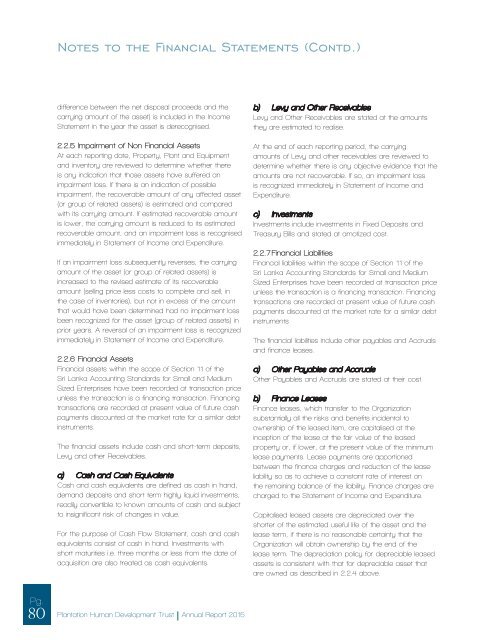PHDT Annual Report 2015
Create successful ePaper yourself
Turn your PDF publications into a flip-book with our unique Google optimized e-Paper software.
Notes to the Financial Statements (Contd.)<br />
difference between the net disposal proceeds and the<br />
carrying amount of the asset) is included in the Income<br />
Statement in the year the asset is derecognised.<br />
2.2.5 Impairment of Non Financial Assets<br />
At each reporting date, Property, Plant and Equipment<br />
and inventory are reviewed to determine whether there<br />
is any indication that those assets have suffered an<br />
impairment loss. If there is an indication of possible<br />
impairment, the recoverable amount of any affected asset<br />
(or group of related assets) is estimated and compared<br />
with its carrying amount. If estimated recoverable amount<br />
is lower, the carrying amount is reduced to its estimated<br />
recoverable amount, and an impairment loss is recognised<br />
immediately in Statement of Income and Expenditure.<br />
If an impairment loss subsequently reverses, the carrying<br />
amount of the asset (or group of related assets) is<br />
increased to the revised estimate of its recoverable<br />
amount (selling price less costs to complete and sell, in<br />
the case of inventories), but not in excess of the amount<br />
that would have been determined had no impairment loss<br />
been recognized for the asset (group of related assets) in<br />
prior years. A reversal of an impairment loss is recognized<br />
immediately in Statement of Income and Expenditure.<br />
2.2.6 Financial Assets<br />
Financial assets within the scope of Section 11 of the<br />
Sri Lanka Accounting Standards for Small and Medium<br />
Sized Enterprises have been recorded at transaction price<br />
unless the transaction is a financing transaction. Financing<br />
transactions are recorded at present value of future cash<br />
payments discounted at the market rate for a similar debt<br />
instruments.<br />
The financial assets include cash and short-term deposits,<br />
Levy and other Receivables.<br />
a) Cash and Cash Equivalents<br />
Cash and cash equivalents are defined as cash in hand,<br />
demand deposits and short term highly liquid investments,<br />
readily convertible to known amounts of cash and subject<br />
to insignificant risk of changes in value.<br />
For the purpose of Cash Flow Statement, cash and cash<br />
equivalents consist of cash in hand. Investments with<br />
short maturities i.e. three months or less from the date of<br />
acquisition are also treated as cash equivalents.<br />
b) Levy and Other Receivables<br />
Levy and Other Receivables are stated at the amounts<br />
they are estimated to realise.<br />
At the end of each reporting period, the carrying<br />
amounts of Levy and other receivables are reviewed to<br />
determine whether there is any objective evidence that the<br />
amounts are not recoverable. If so, an impairment loss<br />
is recognized immediately in Statement of Income and<br />
Expenditure.<br />
c) Investments<br />
Investments include investments in Fixed Deposits and<br />
Treasury Bills and stated at amotized cost.<br />
2.2.7 Financial Liabilities<br />
Financial liabilities within the scope of Section 11 of the<br />
Sri Lanka Accounting Standards for Small and Medium<br />
Sized Enterprises have been recorded at transaction price<br />
unless the transaction is a financing transaction. Financing<br />
transactions are recorded at present value of future cash<br />
payments discounted at the market rate for a similar debt<br />
instruments<br />
The financial liabilities include other payables and Accruals<br />
and finance leases.<br />
a) Other Payables and Accruals<br />
Other Payables and Accruals are stated at their cost<br />
b) Finance Leases<br />
Finance leases, which transfer to the Organization<br />
substantially all the risks and benefits incidental to<br />
ownership of the leased item, are capitalised at the<br />
inception of the lease at the fair value of the leased<br />
property or, if lower, at the present value of the minimum<br />
lease payments. Lease payments are apportioned<br />
between the finance charges and reduction of the lease<br />
liability so as to achieve a constant rate of interest on<br />
the remaining balance of the liability. Finance charges are<br />
charged to the Statement of Income and Expenditure.<br />
Capitalised leased assets are depreciated over the<br />
shorter of the estimated useful life of the asset and the<br />
lease term, if there is no reasonable certainty that the<br />
Organization will obtain ownership by the end of the<br />
lease term. The depreciation policy for depreciable leased<br />
assets is consistent with that for depreciable asset that<br />
are owned as described in 2.2.4 above.<br />
Pg.<br />
80 Plantation Human Development Trust <strong>Annual</strong> <strong>Report</strong> <strong>2015</strong>


